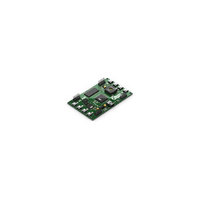ATAVRXPLAIN Atmel, ATAVRXPLAIN Datasheet - Page 4

ATAVRXPLAIN
Manufacturer Part Number
ATAVRXPLAIN
Description
KIT EVAL FOR ATXMEGA128A1
Manufacturer
Atmel
Series
AVR® XMEGAr
Type
MCUr
Specifications of ATAVRXPLAIN
Contents
Board
Silicon Manufacturer
Atmel
Core Architecture
AVR
Silicon Core Number
ATmega128A1
Silicon Family Name
AVR XMEGA
Kit Contents
Board
Rohs Compliant
Yes
For Use With/related Products
ATXMEGA128A1
Lead Free Status / RoHS Status
Lead free / RoHS Compliant
Available stocks
Company
Part Number
Manufacturer
Quantity
Price
Company:
Part Number:
ATAVRXPLAIN
Manufacturer:
Atmel
Quantity:
2
2.4 Clock Prescaling
2.5 Clock Source Switching
4
AVR1010
Minimize power consumption by using the deepest allowable sleep modes at any
time, and running as fast as possible to minimize time spent in ACTIVE mode.
Although it is recommended to run the CPU as fast as possible to minimize the time
spent in ACTIVE mode, there are situations where it is better to reduce the clock rate.
These situations commonly involve waiting in ACTIVE or IDLE mode for something
that takes a fixed amount of time, e.g. serial communication. In these cases, one
should avoid generating higher CPU and peripheral clock frequencies than are
needed for the active peripherals. This may be achieved by using clock prescaling,
which can be changed without causing glitches in the clock signal.
If prescaling is done internally in several peripherals, power can be conserved by
prescaling with the largest common factor as early as possible in the clock distribution
chain. This principle is illustrated in Figure 2-1.
Figure 2-1: Peripherals without and with common prescaling by largest factor.
Note that since the prescaling also affects the CPU clock, it might not always be
desirable to perform this common prescaling in ACTIVE mode because computations
will take longer.
Minimize power consumption by actively using prescaling, especially when waiting in
ACTIVE or IDLE mode.
One should avoid generating higher system clock rates than are actually needed. In
the ideal case, prescaling is unnecessary. This can be achieved by switching
between clock sources.
As an example, it is preferable to generate a 16MHz system clock by use of the PLL
with the 2MHz RC oscillator as reference, rather than the 32MHz RC oscillator with
prescaling to 16MHz. External clock sources may also be a good choice, especially if
they are already available in the system and therefore come with no extra “cost”.
The wake-up delay for the device depends on which clock source is used for the
system clock. One way to reduce this delay is to switch between clock sources so
that the device goes to sleep and wakes up with a fast-responding clock source.
System
clock
prescaling
No
Peripheral
clock
Peripheral w/
prescaling by
Peripheral w/
prescaling by
Peripheral w/
prescaling by
256
64
8
System
clock
Prescaling by
8
Peripheral
clock
8267B-AVR-12/10
Peripheral w/
no prescaling
Peripheral w/
prescaling by
Peripheral w/
prescaling by
32
8













